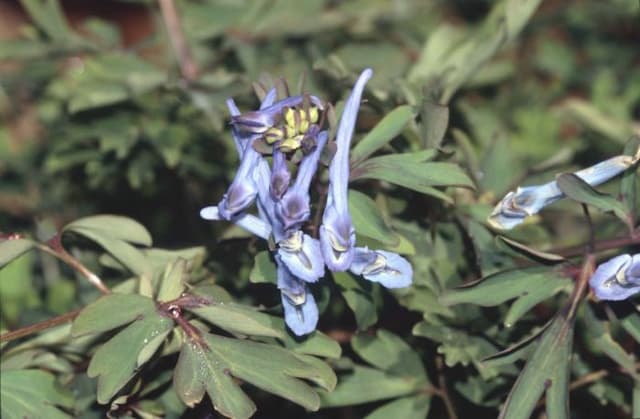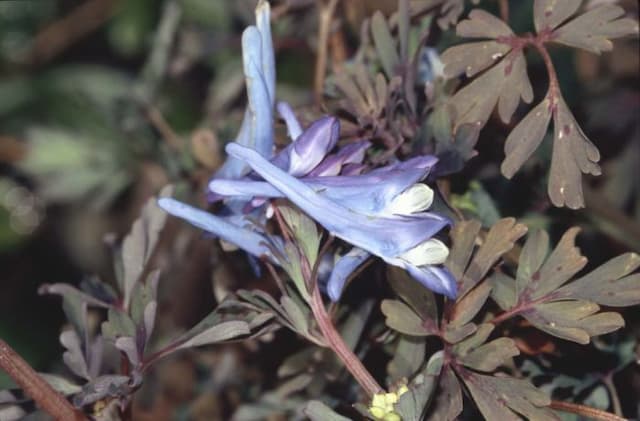Bleeding heart Dicentra formosa

ABOUT
The common name for Dicentra formosa is Western bleeding heart. This plant is recognized for its distinct, charming flowers and graceful foliage. The flowers are heart-shaped, with an outer set of petals that are usually pink or occasionally white. They dangle elegantly from arching stems, creating a whimsical appearance. Underneath the outer petals, there are inner petals that form a distinctive pouch-like shape, which gives the blooms a layered and intricate look. The foliage of the Western bleeding heart is also attractive, composed of soft, fern-like leaves. The leaves are divided into segments, giving them a delicate, lacy texture that complements the flowers. Their color is a rich, blue-green hue, which often turns a golden yellow as the seasons progress into fall. This plant is commonly found in woodland settings and shaded gardens, where it adds a touch of romance and cottage charm. It tends to form clumps that are adorned with the heart-shaped flowers in late spring to early summer, often extending the display of color and texture in the garden. Overall, the Western bleeding heart stands out with its unique flower shape and lush foliage, making it a beloved choice for many plant enthusiasts and gardeners looking to add a touch of elegance to shady spots in the landscape.
About this plant
 Names
NamesFamily
Papaveraceae
Synonyms
Pacific Bleeding Heart, Western Bleeding Heart, Formosa Bleeding Heart
Common names
Diclytra formosa, Fumaria formosa.
 Toxicity
ToxicityTo humans
Western bleeding heart is considered toxic if ingested. The plant contains isoquinoline alkaloids which can cause symptoms of poisoning. If consumed, these alkaloids can cause symptoms such as vomiting, diarrhea, convulsions, and in severe cases, respiratory issues. Care should be taken to avoid ingestion, and if symptoms occur, seek medical attention promptly.
To pets
Western bleeding heart is also toxic to pets, such as dogs and cats. The isoquinoline alkaloids within the plant can lead to gastrointestinal upset, resulting in symptoms such as drooling, nausea, vomiting, and diarrhea. In more serious cases, tremors or seizures may occur. If a pet ingests this plant, it is important to contact a veterinarian as soon as possible.
 Characteristics
CharacteristicsLife cycle
Perennials
Foliage type
Deciduous
Color of leaves
Green
Flower color
Pink
Height
1-2 feet (30-60 cm)
Spread
1-2 feet (30-60 cm)
Plant type
Herb
Hardiness zones
3-9
Native area
North America
Benefits
 General Benefits
General Benefits- Attracts pollinators: Dicentra formosa, commonly known as Pacific bleeding heart, is known to attract bees and other pollinators, which are vital for the pollination of plants and the overall health of the ecosystem.
- Low maintenance: Pacific bleeding heart is recognized for its low maintenance requirements, thriving in shady gardens where other plants might struggle.
- Aesthetic appeal: With its heart-shaped flowers and fern-like foliage, this plant adds unique visual interest to woodland gardens or shaded landscape areas.
- Erosion control: This plant's root system can help stabilize soil in areas that are prone to erosion, such as on slopes or in shaded, moist environments.
- Shade tolerance: Pacific bleeding heart is well-suited for shady areas, providing gardeners with a flowering plant option where sun-loving plants won't thrive.
- Habitat creation: It serves as a habitat for various species of insects, thereby contributing to the biodiversity of its environment.
- Drought-resistant: Once established, the Pacific bleeding heart can tolerate periods of drought, making it suitable for climates with intermittent dry seasons.
 Medical Properties
Medical Properties- Analgesic: Dicentra formosa, commonly known as Pacific bleeding heart, has compounds that may have pain-relieving properties.
- Sedative: It has traditionally been used by Native American tribes to produce a sedative effect.
- Antispasmodic: The plant has been utilized for its potential to alleviate spasms.
 Air-purifying Qualities
Air-purifying QualitiesThis plant is not specifically known for air purifying qualities.
 Other Uses
Other Uses- Dicentra formosa, commonly known as bleeding heart, is often used as a dye plant due to its pigments, which can impart colors to fabrics and materials.
- The fresh or dried flowers of bleeding heart can be added to potpourri mixes for their interesting shape and potential fragrance.
- Bleeding heart plants are frequently used in butterfly gardens as they attract various pollinators, including butterflies and bees.
- In landscaping, bleeding heart is valued for its ability to thrive in shady areas, providing ground cover and greenery where other plants might struggle to grow.
- The bleeding heart is sometimes used as a teaching tool in botanical education due to its unique heart-shaped flowers and dissected leaves.
- The fern-like foliage of bleeding heart provides a delicate texture to floral arrangements, especially in springtime bouquets and decorations.
- Because of its appealing foliage and flowers, bleeding heart is often used as a motif in art, particularly in botanical illustration and nature-inspired designs.
- In folklore, bleeding heart plants are sometimes included in gardens designed to attract fairies or as part of a fairy garden theme.
- Bleeding heart seed pods, which have an ornamental quality, can be used in dried floral crafts and jewelry making.
- During Victorian times, the unique appearance of bleeding heart flowers was used as a secret symbol in the language of flowers to communicate sentiments of love and passion.
Interesting Facts
 Feng Shui
Feng ShuiThe Western Bleeding Heart is not used in Feng Shui practice.
 Zodiac Sign Compitability
Zodiac Sign CompitabilityThe Western Bleeding Heart is not used in astrology practice.
 Plant Symbolism
Plant Symbolism- Romantic love: Dicentra formosa, commonly known as Bleeding Heart, often symbolizes deep romantic affection due to its heart-shaped flowers.
- Compassion and empathy: The characteristic appearance of the flower, resembling a "bleeding heart", conveys feelings of sympathy and understanding.
- Elegance and grace: This plant's delicate and intricate blossoms are associated with qualities of refinement and poise.
- Rejection: On the flip side, Bleeding Heart can also represent rejection or the feeling of being heartbroken, as the flower's appearance gives the impression of a broken or "bleeding" heart.
 Water
WaterThe Pacific Bleeding Heart should be watered deeply once a week, providing one to two gallons of water per plant. During the summer months, if the weather is exceptionally hot and dry, increase watering to twice a week. Ensure that the soil is moist but not waterlogged, as this can lead to root rot. In the winter, reduce watering since the plant will be dormant and won't require as much moisture. Always check the top inch of soil for dryness before watering to prevent overwatering.
 Light
LightThe Pacific Bleeding Heart thrives in partial to full shade. It is best to plant them in a spot that receives filtered sunlight or dappled shade. Avoid direct afternoon sun, which can scorch the delicate foliage. A location under deciduous trees that provide light shade or on the north side of a building where it can get morning sun and afternoon shade is ideal.
 Temperature
TemperatureThe Pacific Bleeding Heart performs well in a range of temperatures, but it prefers cooler environments. The ideal temperature range is between 50°F and 75°F. It can tolerate temperatures as low as 20°F in winter and as high as 85°F in summer, but prolonged exposure to extremes outside of its comfort zone can stress the plant.
 Pruning
PruningPrune the Pacific Bleeding Heart to remove dead or damaged stems and to promote a more compact growth habit. Pruning is best done in late winter or early spring before new growth begins. Cut back any old foliage at the end of the growing season or in early spring to make room for fresh growth. Minimal pruning throughout the growing season can be performed to shape the plant and encourage health.
 Cleaning
CleaningNot needed
 Soil
SoilPacific Bleeding Heart (Dicentra formosa) thrives in moist, well-draining soil rich in organic matter. A mix of loam, peat moss, and perlite or sand can create an ideal environment. Aim for a slightly acidic to neutral pH, between 6.0 and 7.0 for optimal growth.
 Repotting
RepottingThe Pacific Bleeding Heart should be repotted every 2-3 years to refresh the soil and accommodate root growth. It's best to repot in the spring before the plant enters its active growing season.
 Humidity & Misting
Humidity & MistingPacific Bleeding Heart prefers moderate to high humidity levels, but it's adaptable to average home humidity. Aim for a humidity level between 40-50% for the best growth.
 Suitable locations
Suitable locationsIndoor
Place Pacific Bleeding Heart in bright, indirect light and ensure high humidity.
Outdoor
Plant in partial shade, in moist, well-draining soil.
Hardiness zone
4-9 USDA
 Life cycle
Life cycleThe life of Pacific bleeding heart (Dicentra formosa) begins when seeds germinate in moist, cool conditions, typically in early spring. The seedlings soon develop into rosettes of fern-like foliage from which arise delicate stems. By late spring to early summer, the stems bear the plant’s distinctive heart-shaped, pink to purple flowers, which are pollinated by bees and other insects. After flowering, the plant sets seed in small pods that burst open when mature to disperse the seeds. The foliage often goes dormant and dies back in the summer heat, especially in drier conditions, but the root system remains alive underground. The plant rests as a tuberous root throughout the winter until favorable conditions return, triggering the commencement of a new growth cycle in spring.
 Propogation
PropogationPropogation time
Spring-Early Summer
Propogation: The Western bleeding heart, or Dicentra formosa, is commonly propagated by division, typically performed in early spring or fall. During this process, carefully lift the clump of the plant from the soil with a spade, ensuring a generous amount of root and soil is included. Using a sharp, clean knife or spade, divide the clump into smaller sections, each with at least one growing shoot and a portion of the root system. Replant the divisions immediately at the same soil depth they were originally growing, allowing adequate space between plants for air circulation and growth. Water the new plantings thoroughly to help establish the new roots in their location. This method is favored as it maintains the characteristics of the parent plant and allows for quick establishment in the garden.









